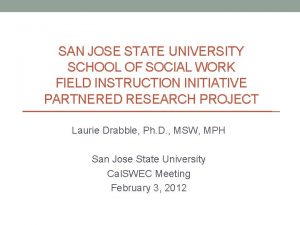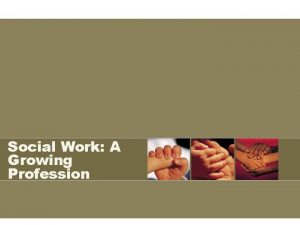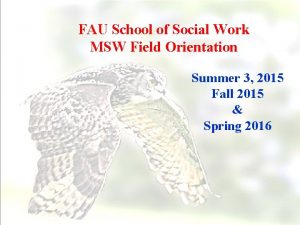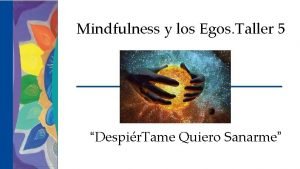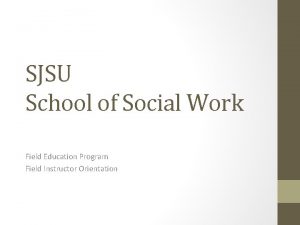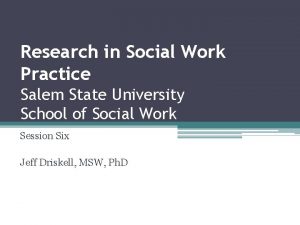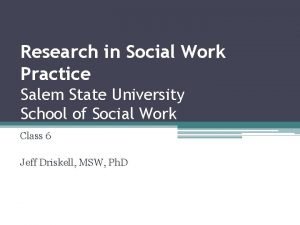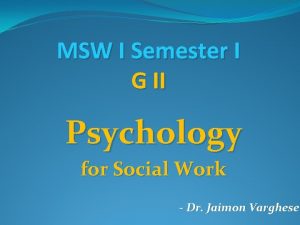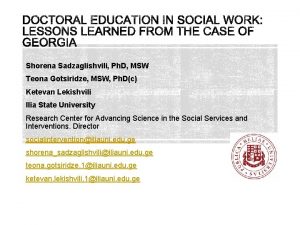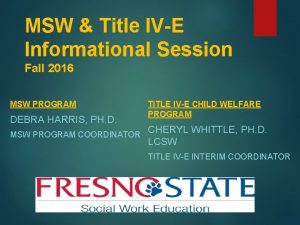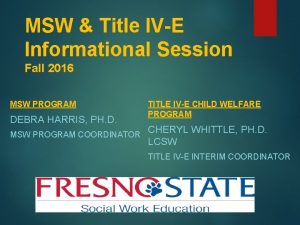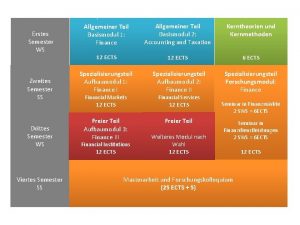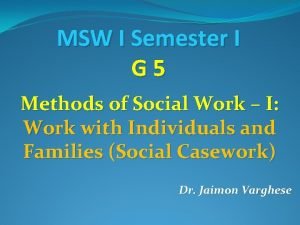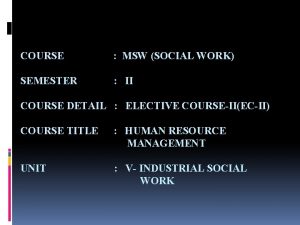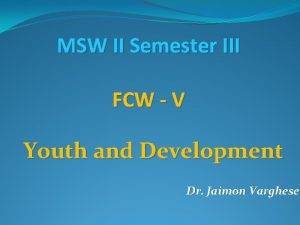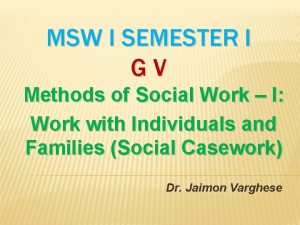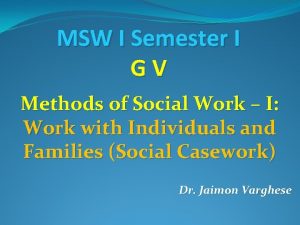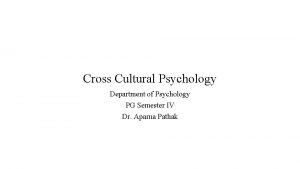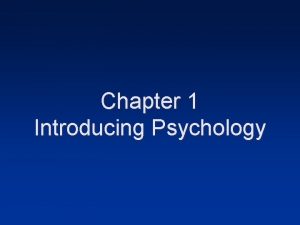MSW I Semester I G II Psychology for


































































- Slides: 66

MSW I Semester I G II Psychology for Social Work - Dr. Jaimon Varghese

3. Psychological & Social Processes in Behaviour 3. 1. Learning and motivation 3. 2. Emotions 3. 3. Perception 3. 4. Attitudes, 3. 5 Prejudices, Biases & Stereotyping 22 -01 -2022 17: 00: 41 Psychology for Social Workers 2

3. 1. Learning and motivation 3. 1. 1 Learning 3. 1. 2 Motivation 22 -01 -2022 17: 00: 42 Psychology for Social Workers 3

3. 1. 1 • Learning A relatively permanent change in cognition, knowledge or behaviour or the cognitive process of acquiring skill or knowledge through study, experience or teaching 22 -01 -2022 17: 00: 43 Psychology for Social Workers 4

3. 1. 1. Learning • Learning is an essential aspect of behaviour • Learning is the increase in the amount of concepts in the memory of an individual. • Simon defined learning as changes in a system that result in improved performance over time on tasks similar to those done previously. It suggests continuous and cumulative improvement 22 -01 -2022 17: 00: 44 Psychology for Social Workers 5

3. 1. 1 Learning • Learning is the process which develops or changes the behaviour of the learner to a degree of permanence, usually with the intervention of an educator. • Learning involves the child in totality and relates to the acquisition of facts and modification of concepts, principles, attitudes, emotions and skills. • Learning refers to acquiring new concepts, new skills and new knowledge to perform a job. 22 -01 -2022 17: 00: 46 Psychology for Social Workers 6

3. 1. 1 Learning • Any activity can be called learning so far as it develops the individual and makes him alter behaviour and experiences different from what that would otherwise have been (Woodworth, 1945) • Learning is the acquisition of new behaviour or the strengthening or weakening of old behaviour as the result of experience (Henry P Smith, 1962) • The term learning covers the very modification in behaviour to meet environmental requirements (Gardner Murphy, 1968) 22 -01 -2022 17: 00: 50 Psychology for Social Workers 7

3. 1. 1 • Learning Gagne (1985) identifies five major categories of learning: • verbal information, • intellectual skills, • cognitive strategies, • motor skills and • attitudes. 22 -01 -2022 17: 00: 51 Psychology for Social Workers 8

3. 1. 1 Learning Gagne suggests that learning tasks for intellectual skills can be organized in a hierarchy according to complexity: • stimulus recognition, • response generation, • procedure following, • use of terminology, • discriminations, • concept formation, • rule application, and • problem solving. 22 -01 -2022 17: 00: 52 Psychology for Social Workers 9

3. 1. 1 Learning: theories 1. Connectionism (Thorndike, E (1913) Educational Psychology: The Psychology of Learning, New York: Teachers College Press) • Thorndike's theory consists of three primary laws: (1) law of effect - responses to a situation which are followed by a rewarding state of affairs will be strengthened and become habitual responses to that situation, (2) law of readiness a series of responses can be chained together to satisfy some goal which will result in annoyance if blocked, and (3) law of exercise - connections become strengthened with practice and weakened when practice is discontinued. A corollary of the law of effect was that responses that reduce the likelihood of achieving a rewarding state (i. e. , punishments, failures) will decrease in strength. 22 -01 -2022 17: 00: 54 Psychology for Social Workers 10

3. 1. 1 Learning theories 2. Drive Reduction Theory (Hull, C. (1943) Principles of Behaviour, New York: Appleton-Century-Crofts): Drive is essential in order for responses to occur (i. e. , the student must want to learn). Learning must satisfy the learner's wants). 3. Gestalt Theory (Wertheimer, M (1959) Productive Thinking, New York: Harper & Row): the idea of "grouping”, forming a gestalt (pattern or fullness), insightful problem-solving. 4. Classical conditioning of Ian Pavlov: Stimulus – Response Theory 5. Operant conditioning of BF Skinner: Reward and punishment; behaviour modification [Skinner, B. F. (1954) The science of learning and the art of teaching, Harvard Educational Review, 24(2), 86 -97] 22 -01 -2022 17: 00: 58 Psychology for Social Workers 11

3. 1. 1 Learning theories 6. Social Learning Theory [Bandura, A. (1977) Social Learning Theory, New York: General Learning Press]: most human behaviour is learned observationally through modelling: from observing others one forms an idea of how new behaviours are performed • The component processes underlying observational learning are: (1) Attention, including modelled events (distinctiveness, affective valence, complexity, prevalence, functional value) and observer characteristics (sensory capacities, arousal level, perceptual set, past reinforcement), (2) Retention, including symbolic coding, cognitive organization, symbolic rehearsal, motor rehearsal), (3) Motor Reproduction, including physical capabilities, self-observation of reproduction, accuracy of feedback, and (4) Motivation, including external, vicarious and self reinforcement. 22 -01 -2022 17: 00: 59 Psychology for Social Workers 12

3. 1. 1 Learning Transfer of learning: • positive, • negative & • zero transfer Factors influencing learning: • Knowledge of results and feedback • Methods of learning • Motivational variables • Fatigue 22 -01 -2022 17: 01: 00 Psychology for Social Workers 13

3. 1. 2 Motivation • Motivation is the intention of achieving a goal, leading to goal-directed behaviour. • Some human activity seems to be best explained by postulating an inner directing drive. • A drive is often considered to be an innate biological mechanism that determines the organism's activity, a motive is defined as an innate mechanism modified by learning. 22 -01 -2022 17: 01: 00 Psychology for Social Workers 14

3. 1. 2 Motivation • Human drives serve to satisfy biological needs, such as hunger, while motives serve to satisfy needs that are not directly tied to the body requirements, such as companionship. • Motives are sometimes classed as deficiency motives, such as the need to remove the physiological deficiency of hunger or thirst, or abundancy motives, i. e. , motives to attain greater satisfaction and stimulation. 22 -01 -2022 17: 01 Psychology for Social Workers 15

3. 1. 2 Motivation theory 1. Maslow's hierarchy of needs is a theory in psychology that Abraham Maslow proposed in his 1943 paper A Theory of Human Motivation • He classified motives into five developmental levels, with the satisfaction of physiological needs – • 1. survival, 2. safety, 3. belongingness, 4. esteem and 5. self-actualization needs. According to Maslow, the basic needs must be satisfied before successively higher needs can emerge. 22 -01 -2022 17: 01 Psychology for Social Workers 16

3. 1. 2 Motivation theory • Maslow's hierarchy of needs is often depicted as a pyramid consisting of five levels: the four lower levels are grouped together as deficiency needs, while the top level is referred to as being needs. • While our deficiency needs must be met, our being needs are continually shaping our behaviour. • The basic concept is that the higher needs in this hierarchy only come into focus once all the needs that are lower down in the pyramid are mainly or entirely satisfied. 22 -01 -2022 17: 01: 02 Psychology for Social Workers 17

3. 1. 2 Motivation theory 2. Clayton Alderfer further expanded Maslow's hierarchy of needs by categorizing the hierarchy into his ERG theory (Existence, Relatedness and Growth). • Alderfer categorized the lower order needs (Physiological and Safety) into the Existence category. • He fit Maslow's interpersonal love and esteem needs into the relatedness category. • The growth category contained the Self Actualization and self esteem needs. 22 -01 -2022 17: 01: 04 Psychology for Social Workers 18

3. 1. 2 Motivation theory 3. Frederick Herzberg (1923 - 2000) proposed the Two Factor theory of human motivation. According to his theory people were influenced by two factors. • Satisfaction and psychological growth was a factor of motivation factors. Dissatisfaction was a result of hygiene factors. • Essentially, hygiene factors were needed to ensure an employee was not dissatisfied. • Hygiene Factors include working conditions, Salary, Status, Security, interpersonal relations • Motivation Factors Include Achievement, Recognition, Responsibility, Advancement and Growth 22 -01 -2022 17: 01: 05 Psychology for Social Workers 19

3. 1. 2 Motivation theory • The combination of hygiene and motivation factors can result in four conditions. • High Hygiene / High Motivation: The ideal situation where employees are highly motivated and have few complaints • High Hygiene / Low Motivation: Employees have few complaints but are not highly motivated. "The job is a paycheck" situation • Low Hygiene / High Motivation: Employees are motivated but have a lot of complaints. A situation where the job is exciting and challenging but salaries and work conditions are not up to par. • Low Hygiene / Low Motivation: The worst situation. Unmotivated employees with lots of complaints. 22 -01 -2022 17: 01: 07 Psychology for Social Workers 20

3. 1. 2 Motivation theory 4. David Clarence Mc. Clelland (1917 - 1998) proposed a content theory of motivation: human motivation are a result of three manifest needs. • These are the need for achievement (NAch), the need for power (N-Pow) and the need for affiliation (N-Affil). The importance of each need varies from individual and cultural background. 22 -01 -2022 17: 01: 09 Psychology for Social Workers 21

3. 1. 2 Motivation theory 5. Victor Vroom proposed the Expectancy theory of motivation. The three main factors of this theory are Valence, Expectancy, and Instrumentality. • Valence is the importance placed upon the reward. • Expectancy is the belief that efforts are linked to performance. • Instrumentality is the belief that performance is related to rewards. 22 -01 -2022 17: 01: 10 Psychology for Social Workers 22

3. 1. 2 Motivation theory • For example a salesman's expectancy is his belief that more number of phone calls (effort) will result in higher sales (performance). His instrumentality is that higher sales (performance) will result in higher commissions (rewards). His valence is the importance attached to the commissions (rewards). • These three factors result in motivation. If any one of these factors doesn't exist then motivation vanishes. If the salesman doesn't believe greater effort leads to performance then there is no motivation. Similarly, if commissions don't increase with sales then instrumentality disappears. • According to the expectancy theory the amount of effort people exert on a specific task depends on their expectations of the outcome. 22 -01 -2022 17: 01: 11 Psychology for Social Workers 23

3. 2. Emotions • A feeling: the emotions of joy, sorrow, reverence, Love, hate, anger, courage, fear, pleasure and disgust. • Emotions are significant factors of behaviour; • Subjective experience of feeling • aroused by external stimuli and • a corresponding verbal or nonverbal reaction • A mental state that arises spontaneously • rather than through conscious effort and • is often accompanied by physiological changes; 22 -01 -2022 17: 01: 12 Psychology for Social Workers 24

3. 2. Emotions Emotional development • Bridges (1932): appearance of basic emotions: Birth (excitement) – 3 months (elation, delight & distress) – 6 months (disgust, fear & anger) – 18 months (affection) • The complex emotions (cultural conditioning or combining the basic emotions - interpersonal anger and disgust form contempt) 22 -01 -2022 17: 01: 14 Psychology for Social Workers 25

3. 2. Emotions • Controlled and expressed emotions • Emotional dispositions (mood / temperament / personality trait) • During intense emotional experience, sympathetic division of autonomous nervous system prepares body for emergency situation 22 -01 -2022 17: 01: 16 Psychology for Social Workers 26

3. 2. Emotions - Theory • William James & Carl Lange (1880): Perception of a situation – bodily reaction – notice our reaction and label it an emotion; we feel afraid because we tremble. The James. Lange theory proposes that conscious conclusions about what we are "feeling" form in reaction to physiological changes occurring in the body. • We have experiences, and as a result, our autonomic nervous system creates physiological events such as muscular tension, heart rate increases, perspiration, dryness of the mouth, etc. This theory proposes that emotions happen as a result of these, rather than being the cause of them. The bodily sensation prepares us for action, as in the Fight-or-Flight reaction. Emotions grab our attention and at least attenuate slower cognitive processing. 22 -01 -2022 17: 01: 19 Psychology for Social Workers 27

3. 2. Emotions - Theory • Walter Bradford Cannon and Philip Bard (1920): Joint arousal of cortex and sympathetic nervous system from (hypo) thalamus upon the stimulation. • The Cannon-Bard Approach proposes that the lower brain initially receives emotion-producing information and then relays it simultaneously to the higher cortex for interpretation and to the nervous system to trigger physiological responses. • We feel emotions first, and then feel physiological changes, such as muscular tension, sweating, etc. 22 -01 -2022 17: 01: 22 Psychology for Social Workers 28

3. 2. Emotions - Theory • The Schachter-Singer Approach gives highest importance to the cognitive skills that create an interpretation of the situation and so provide a framework for the individual's behavioural response. • Cognitive physiological theory (Schatcher, 1971) • stimulus factor (sensory inputs), • physiological (sympathetic) and • cognitive factors (interpretation - evaluations and judgments - based on past experience or memory) - for an emotion to occur 22 -01 -2022 17: 01: 23 Psychology for Social Workers 29

3. 2. Emotions - Theory • The Opponent-Process Approach views emotions as sets of pairs, one positive and one negative. When an emotion-producing stimulus is present, one of the pair is suppressed so that the more situationally appropriate emotion is felt intensely. • Performance is optimal at moderate level of emotional arousal 22 -01 -2022 17: 01: 25 Psychology for Social Workers 30

3. 3. Perception • Perception is an important factor of behaviour • Perception is the way people organize and interpret the world around them in order to give meaning to their surroundings. • People’s behaviour is based on how they interpret reality, not reality itself. • The world that is perceived is the world that is behaviourally important. • Percept is the representation of what is perceived; basic component in the formation of a concept. 22 -01 -2022 17: 01: 26 Psychology for Social Workers 31

3. 3. Perception • Perception is our awareness of the world and its contents through sensory experience; Awareness and understanding of one's environment (awareness of touch, sights, sounds) • Perception is the process of acquiring, interpreting, selecting, and organizing sensory information. • The ability to make sense of what one sees, hears, feels, tastes or smells; the feelings, attitudes, and images people have of different places, peoples, and environments. • The psychological ability to process or use information received through the sense organs. 22 -01 -2022 17: 01: 27 Psychology for Social Workers 32

3. 3. Perception • Our perception including moral, psychological, and/or aesthetic qualities alters our world according to our understanding, insight, and experience. • Perception typically refers to the activity of processing physical input (pressure waves, photons) into convenient abstractions (pitch/timbre, colour) or cognition; the process of classifying sensations. 22 -01 -2022 17: 01: 29 Psychology for Social Workers 33

3. 3. Perception • The oldest quantitative law in psychology is the Weber-Fechner Law, which quantifies the relationship between the intensity of physical stimuli and their perceptual effects. • It was the study of perception that gave rise to the Gestalt school of psychology, with its emphasis on holistic approaches. 22 -01 -2022 17: 01: 30 Psychology for Social Workers 34

Principles of Perception • The principle of the 'selectivity' of perception refers to foregrounding and backgrounding. The terms figure and ground explain how we use elements of the scene which are similar in appearance and shape and group them together as a whole. • The concept of 'figure' and 'ground' in perception to the Gestalt psychologists: notably Max Wertheimer (1880 -1943), Wolfgang Köhler (18871967) and Kurt Koffka (1886 -1941). Similar elements (figure) are contrasted with dissimilar elements (ground) to give the impression of a whole. 22 -01 -2022 17: 01: 32 Psychology for Social Workers 35

Principles of Perception • The principle of similarity states that things which share visual characteristics such as shape, size, color, texture, value or orientation will be seen as belonging together. • The principle of proximity or contiguity states that things which are closer together will be seen as belonging together. • The principle of continuity predicts the preference for continuous figures. 22 -01 -2022 17: 01: 34 Psychology for Social Workers 36

Principles of Perception • The principle of closure applies when we tend to see complete figures even when part of the information is missing. It is speculated this is a survival instinct, allowing us to complete the form of a predator even with incomplete information. • The principle of area states that the smaller of two overlapping figures is perceived as figure while the larger is regarded as ground. 22 -01 -2022 17: 01: 34 Psychology for Social Workers 37

Principles of Perception • The principle of symmetry describes the instance where the whole of a figure is perceived rather than the individual parts which make up the figure. • All of these principles of perceptual organization serve the overarching principle of pragnänz, which is that the simplest and most stable interpretations are favoured. 22 -01 -2022 17: 01: 35 Psychology for Social Workers 38

Factors influencing Perception • Factors influencing Perception: the perceiver, the target and the situation. • Factors in the Perceiver: • Attitudes • Motives • Interest • Experience • Expectations 22 -01 -2022 17: 01: 36 Psychology for Social Workers 39

Factors influencing Perception • Factors in the Target: • Motion • Sounds • Size • Background • Proximity 22 -01 -2022 17: 01: 36 Psychology for Social Workers 40

Factors influencing Perception • Factors in the Situation: • Time • Work setting • Social setting 22 -01 -2022 17: 01: 37 Psychology for Social Workers 41

3. 4. Attitudes • A way of social perception • Attitude is the type of adjustment of an individual towards a person, group or institution (B. Kuppuswamy, Introduction to Social Psychology, 1961) • Schiffman and Kanuk (1996) defines • • attitude as a learned predisposition • to behave in a consistently favourable or unfavourable way • with respect to a given object. The main characteristics of attitudes are indicated by the key words in the definition: learned, predisposition, behave. 22 -01 -2022 17: 01: 38 Psychology for Social Workers 42

3. 4. Attitudes • A state of preparedness or readiness to stimuli or a particular situation • Attitudes reveal a person’s religious, political and professional identity • Attitude towards social change – Reactionary / Conservative / Conformist / Moderate / Liberal / Progressive / Radical • Attitudes are individualistic, but shared by members of a group • Influence our judgement regarding the desirability & behaviour of others 22 -01 -2022 17: 01: 39 Psychology for Social Workers 43

Attitude towards social change 1. Reactionary 2. Conservative 3. Conformist 4. Moderate 5. Liberal 6. Progressive 7. Radical 22 -01 -2022 17: 01: 42 Psychology for Social Workers 44

3. 4. Attitudes • Attitudes are not innate, but learnt through socialisation • Attitudes are lasting; however change through interaction, exposure or group discussion • Attitudes are well defined object (frame) of reference and can be measured by psychological tests (Thurston’s equal appearing intervals / Likert’s summated rating / Bogardus’ social distance scale) 22 -01 -2022 17: 01: 43 Psychology for Social Workers 45

3. 5. 1. Prejudices • Prejudice, unsubstantiated prejudgment of an individual or group, favourable or unfavourable in character, tending to action in a consonant direction. • The hostility that prejudice can engender and the discrimination to which it may lead on the part of a dominant population toward an ethnic group, gender, religious or linguistic minority have caused great human suffering throughout history. • Prejudice refers to deep-rooted “fear of the stranger, ” religious or nationalist chauvinism, and fear of economic competition. 22 -01 -2022 17: 01: 44 Psychology for Social Workers 46

3. 5. 1. Prejudices • Prejudice is learned and can be reduced when members of different communities work together toward the realization of a common goal or when groups intermarry. • Since prejudice and discrimination each contribute to the origin and growth of the other, prejudice can be reduced by removing discrimination, and a change in discriminatory institutions usually leads to a change in attitudes. • Prejudice is a hostile opinion about some person or class of persons, socially learned and is usually grounded in misconception, misunderstanding, and inflexible generalizations. 22 -01 -2022 17: 01: 45 Psychology for Social Workers 47

3. 5. 1. Prejudices • Prejudice is the process of "pre-judging" something or formation of a judgement without direct or actual experience. • Prejudice generally refers to existing biases toward the members of such groups, often based on social stereotypes, and at its most extreme, becomes denying groups, benefits and rights unjustly or, conversely, unfairly showing unwarranted favour towards others. • Much prejudicial behaviour are picked up at a young age by children emulating their elders' way of thinking and speaking, with no malice intended on the child's part. 22 -01 -2022 17: 01: 46 Psychology for Social Workers 48

3. 5. 1. Prejudices • Prejudice has been termed an adaptive behaviour. • Biased views are often necessary at times for human survival, as we don't always have time to form a personal view on a potential foe before adopting a defensive stance which could save our lives. • To these ends a prejudicial or instinctive view on a person or situation is useful and aids survival, but could also prevent survival if they're prejudicing a potential ally 22 -01 -2022 17: 01: 48 Psychology for Social Workers 49

3. 5. 2. Biases • Cognitive and personal biases in decision making • It is generally agreed that biases can creep into our decision making processes, calling into question the correctness of a decision. • Selective search for evidence - We tend to be willing to gather facts that support certain conclusions but disregard other facts that support different conclusions. 22 -01 -2022 17: 01: 49 Psychology for Social Workers 50

3. 5. 2. Biases • Premature termination of search for evidence - We tend to accept the first alternative that looks like it might work. • Conservatism and inertia - Unwillingness to change thought patterns that we have used in the past in the face of new circumstances • Experiential limitations - Unwillingness or inability to look beyond the scope of our past experiences; rejection of the unfamiliar 22 -01 -2022 17: 01: 50 Psychology for Social Workers 51

3. 5. 2. Biases • Selective perception - We actively screenout information that we do not think is salient • Wishful thinking or optimism - We tend to want to see things in a positive light and this can distort our perception and thinking • Choice-supportive bias occurs when we distort our memories of chosen and rejected options to make the chosen options seem relatively more attractive 22 -01 -2022 17: 01: 52 Psychology for Social Workers 52

3. 5. 2. Biases • Recentness - We tend to place more attention on more recent information and either ignore or forget more distant information • Repetition bias - A willingness to believe what we have been told most often and by the greatest number of different of sources • Anchoring and adjustment - Decisions are unduly influenced by initial information that shapes our view of subsequent information 22 -01 -2022 17: 01: 53 Psychology for Social Workers 53

3. 5. 2. Biases • Group think - Peer pressure to conform to the opinions held by the group • Source credibility bias - We reject something if we have a bias against the person, organization, or group to which the person belongs: We are inclined to accept a statement by someone we like • Incremental decision making and escalating commitment - We look at a decision as a small step in a process and this tends to perpetuate a series of similar decisions 22 -01 -2022 17: 01: 54 Psychology for Social Workers 54

3. 5. 2. Biases • Inconsistency - The unwillingness to apply the same decision criteria in similar situations • Attribution asymmetry - We tend to attribute our success to our abilities and talents, but we attribute our failures to bad luck and external factors. We attribute other's success to good luck, and their failures to their mistakes. • Role fulfillment - We conform to the decision making expectations that others have of someone in our position. 22 -01 -2022 17: 01: 55 Psychology for Social Workers 55

3. 5. 2. Biases • Underestimating uncertainty and the illusion of control - We tend to underestimate future uncertainty because we tend to believe we have more control over events than we really do. We believe we have control to minimize potential problems in our decisions. • Faulty generalizations - In order to simplify an extremely complex world, we tend to group things and people. These simplifying generalizations can bias decision making processes. 22 -01 -2022 17: 01: 58 Psychology for Social Workers 56

3. 5. 2. • Biases Ascription of causality - We tend to ascribe causation even when the evidence only suggests correlation. Just because birds fly to the equatorial regions when the trees lose their leaves, does not mean that the birds migrate because the trees lose their leaves. 22 -01 -2022 17: 01: 59 Psychology for Social Workers 57

3. 5. 3. Stereotyping • Stereotype is a simplified mental picture of an individual or group of people who share certain characteristic (or stereotypical) qualities. • Stereotypes are a relatively value-neutral categorization of behaviour. • Common stereotypes include a variety of allegations about various racial groups, predictions of behaviour based on social status and wealth and allegations based on sex. 22 -01 -2022 17: 02: 01 Psychology for Social Workers 58

3. 5. 3. Stereotyping • Stereotypes are common in the world of drama, where they are often used as a form of dramatic shorthand. • Throughout history, storytellers have drawn from stereotypical characters and situations, in order to quickly connect the audience with new tales. • The word stereotype originated in the world of printing; it was originally a duplicate impression of an original typographical element, used for printing instead of the original. 22 -01 -2022 17: 02: 01 Psychology for Social Workers 59

3. 5. 3. Stereotyping • Over time, this became a metaphor for any set of ideas repeated identically, en masse, with no changes. • Social stereotypes are usually for the purpose of making quick judgements about people. • The housewife-mother subcategory defines cultural expectations about what a mother is supposed to be. Housewife-mothers are taken as better examples of mothers than non-housewife-mothers. 22 -01 -2022 17: 02 Psychology for Social Workers 60

3. 5. 3. Stereotyping • Advocates for public policy changes often have to overcome social stereotypes, while opponents of public policy changes often seek to reinforce them. • Stereotypes invariably refer in a generalized manner to - often arbitrary - groups of people, usually minorities. • "Nazi Germany", "Communist Russia/China", and "Revolutionary France" are all forms of group-speak. 22 -01 -2022 17: 02: 03 Psychology for Social Workers 61

3. 5. 3. Stereotyping • Stereotypes are rigid and resistant to change even in the face of compelling new evidence. • Stereotypes foster intra-group homogeneity. Stereotypes cast certain individuals as exceptions or deviants - 'though you are Jewish, you don't behave as a Jew would, you are different'. • Stereotypes purport to proffer immutable rules applicable to all the members of the group. 22 -01 -2022 17: 02: 03 Psychology for Social Workers 62

3. 5. 3. Stereotyping • Stereotypes develop easily, rigidify surreptitiously, and operate reflexively, providing simple, comfortable, convenient bases for making personal sense of the world. • Stereotypes form the core of racism, sexism, homophobia, and other forms of xenophobia (racial intolerance). • Stereotypes determine the content and thrust of prejudices and propel their advocates to take action against minorities. 22 -01 -2022 17: 02: 04 Psychology for Social Workers 63

3. 5. 3. Stereotyping • It is also claimed that stereotyping reduces the quality of life, lowers the expectations, and curbs the accomplishments of its victims. • Stereotypes are selective filters. Supporting data is hoarded and information to the contrary is ignored. Blacks are supposed to have superior musical and athletic skills. Jews are thought to be brainier in science and shrewder in business. Gays are sensitive and compassionate. And negative stereotypes are attached even to positive social roles - athletes are dumb and violent, soldiers inflexible and programmed. 22 -01 -2022 17: 02: 05 Psychology for Social Workers 64

3. 5. 3. Stereotyping • The term stereotype is often used in a negative sense, and stereotypes are seen by many as undesirable beliefs which can be altered through education and/or familiarisation. • One way to shape stereotypes into effective coping strategies is to bombard their devotees with "exceptions", contexts, and alternative reasoning. 22 -01 -2022 17: 02: 05 Psychology for Social Workers 65

Thank You 22 -01 -2022 17: 02: 07 Psychology for Social Workers 66
 Ut arlington msw
Ut arlington msw Aurora university moodle
Aurora university moodle E-waste definition apes
E-waste definition apes University of memphis school of social work
University of memphis school of social work A flat fee pricing system for msw services
A flat fee pricing system for msw services Ucsf msw
Ucsf msw Trapez i cfaredoshem
Trapez i cfaredoshem Aurora university msw
Aurora university msw Csu stanislaus msw
Csu stanislaus msw Hendrefoelan student village
Hendrefoelan student village Msw scholarships 2019
Msw scholarships 2019 San jose state school of social work
San jose state school of social work Msw
Msw Edall button
Edall button Aka.msw
Aka.msw Sjsu msw advanced standing
Sjsu msw advanced standing F=msb/msw
F=msb/msw Msw el callado
Msw el callado Sjsu msw
Sjsu msw Msw 21 sevilla
Msw 21 sevilla Salem state university school of social work
Salem state university school of social work Salem state msw
Salem state msw Tourniquet nomenclature
Tourniquet nomenclature Canvas csustan
Canvas csustan Tk20 uwf
Tk20 uwf Csumb
Csumb Msw vtmis
Msw vtmis Msw games
Msw games Programski jezik logo naredbe
Programski jezik logo naredbe Turtle programming language
Turtle programming language Western michigan university social work
Western michigan university social work Omprov cellprov
Omprov cellprov Lyckans minut erik lindorm analys
Lyckans minut erik lindorm analys Inköpsprocessen steg för steg
Inköpsprocessen steg för steg A gastrica
A gastrica Strategi för svensk viltförvaltning
Strategi för svensk viltförvaltning Novell typiska drag
Novell typiska drag Variansen formel
Variansen formel Tack för att ni har lyssnat
Tack för att ni har lyssnat Treserva lathund
Treserva lathund Läkarutlåtande för livränta
Läkarutlåtande för livränta Påbyggnader för flakfordon
Påbyggnader för flakfordon Tack för att ni lyssnade
Tack för att ni lyssnade Debatt mall
Debatt mall Tobinskatten för och nackdelar
Tobinskatten för och nackdelar Egg för emanuel
Egg för emanuel En lathund för arbete med kontinuitetshantering
En lathund för arbete med kontinuitetshantering Tack för att ni har lyssnat
Tack för att ni har lyssnat Rutin för avvikelsehantering
Rutin för avvikelsehantering Biologiska arvet
Biologiska arvet Byggprocessen steg för steg
Byggprocessen steg för steg Myndigheten för delaktighet
Myndigheten för delaktighet Presentera för publik crossboss
Presentera för publik crossboss Rbk-mätning
Rbk-mätning Kung som dog 1611
Kung som dog 1611 Densitet vatten
Densitet vatten Tack för att ni lyssnade bild
Tack för att ni lyssnade bild Tack för att ni har lyssnat
Tack för att ni har lyssnat Referatmarkering
Referatmarkering Epiteltyper
Epiteltyper Tät skog karttecken
Tät skog karttecken Vätsketryck formel
Vätsketryck formel Multiplikation med uppställning
Multiplikation med uppställning Autokratiskt ledarskap
Autokratiskt ledarskap Elektronik för barn
Elektronik för barn Adressändring ideell förening
Adressändring ideell förening Borra hål för knoppar
Borra hål för knoppar











